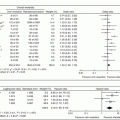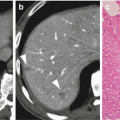Fig. 13.1
Schematic cross-sectional view demonstrating the resection area of distal pancreatectomy with en bloc celiac axis resection (DP-CAR). The dotted line indicates the dissection plane. Adr adrenal gland, Ao aorta, CA celiac axis, CHA common hepatic artery, crus crus of the diaphragm, Du duodenum, g celiac ganglion, IVC inferior vena cava, pl celiac plexus, PV portal vein, SA splenic artery, SV splenic vein
This procedure was originally designed as en bloc lymphadenectomy combined with total gastrectomy and resection of the celiac axis for advanced gastric cancer by Appleby in 1953 [2]. It was first adopted by Nimura in 1976 [3] for patients with advanced pancreatic body cancer with invasion of the celiac axis. A modification to the procedure with preservation of the entire stomach was primarily reported from Japan, which resulted in better postoperative nutritional status [1, 4, 5]. The first report regarding the long-term outcome of DP-CAR was published in 2007 [6], which included the results of 24 consecutive patients with favorable postoperative survival. Nowadays, several pancreatic surgeons have performed this procedure for carcinoma of the body and tail of the pancreas.
In DP-CAR, the entire alimentary tract, including the stomach and bile duct, which are not invaded by the cancer, is preserved. Especially by preserving the stomach, the patient’s nutritional status and tolerance of oral anticancer agents could be maintained. SMA preservation, even with complete eradication of the surrounding plexus, is the key feature of this procedure, which sustains arterial supply to the hepatobiliary system and stomach. Resection of the portal vein and middle colic vessels is an optional procedure.
13.2 Arterial Supply to the Liver and the Stomach After DP-CAR
Although DP-CAR includes en bloc resection of the CA, CHA, and plexus of the SMA, reconstruction of the arterial system is not required because of early development of a collateral arterial circulation via the pancreatoduodenal arcades from the superior mesenteric artery. After division of the CA with the CHA and splenic artery (SA), the hepatic and gastric arterial flow depends on the flow from the gastroduodenal artery (GDA), which should, therefore, definitely be preserved with the pancreatic head during DP-CAR. The collateral pathways via the SMA, pancreatoduodenal arcades, and GDA maintain the arterial blood supply to the hepatobiliary system. Since the collateral pathways also ensure arterial flow to the right gastroepiploic artery, the entire stomach can be preserved (Fig. 13.2).


Fig. 13.2
Schematic drawing of collateral arterial pathways via the pancreatoduodenal arcades from the superior mesenteric artery following DP-CAR. The arrows show the direction of arterial flow from the superior mesenteric artery to the liver and stomach via the pancreatoduodenal arcades. APD anterior pancreatoduodenal arcade, CA celiac axis, CHA common hepatic artery, GDA gastroduodenal artery, GEA right gastroepiploic artery, LGA left gastric artery, PHA proper hepatic artery, PPD posterior pancreatoduodenal arcade, SA splenic artery, SMA superior mesenteric artery
Preoperative coil embolization of the CHA is routinely used to enlarge the collateral arterial pathway in some institutes, so as to reduce ischemia-related complications such as ischemic gastropathy, liver abscess, and perforation of the biliary system [7].
13.3 Selection of Candidates for DP-CAR
Tumor progression is cautiously evaluated mainly with preoperative multi-detector row computed tomography (MD-CT), with supplemental use of magnetic resonance imaging (MRI) and endoscopic ultrasonography (EUS). The indication for DP-CAR is locally advanced ductal adenocarcinoma of the body of the pancreas, such as that involving or abutting the CHA, the root of the SA, and/or the CA, without involvement of the GDA, SMA, and inferior pancreatoduodenal artery. Patients with involvement of less than approximately half the circumference of the SMA plexus should be considered candidates for DP-CAR because complete dissection of the SMA plexus without exposing the cancer can be achieved by dividing the plexus on the side opposite to that of the tumor. For oncologically safe ligation and division of the root of the CA in front of the aorta, a 5–7 mm noncancerous length of the CA from the adventitia of the aorta is required (Fig. 13.3).


Fig. 13.3
Preoperative diagnosis is obtained by multi-detector row computed tomography (MD-CT). (a) The gastroduodenal artery (GDA) is free from the tumor, and invasion of the tumor is limited in the ventral half circumference of the plexus of the superior mesenteric artery (SMA). (b) The tumor involvement toward the celiac axis (CA) was estimated in the axial view. (c) In the same patient, the sagittal view of MD-CT could show the cancer-free area (asterisk) in the root of the CA approximately 7 mm in length. Ao Aorta, CA celiac axis, GDA gastroduodenal artery, PV portal vein, SMA superior mesenteric artery
Even if the tumor of the pancreatic body invades other organs directly, DP-CAR could be completed with concomitant resection of the organs, including the alimentary tract, the left adrenal gland, and/or the left kidney. However, in the case that a tumor has invaded the stomach to a depth that necessitates full-thickness resection, total gastrectomy should be considered because healing of the anastomosis might be disturbed by an insufficient collateral arterial flow.
13.4 Surgical Procedure of DP-CAR
DP-CAR usually includes resection of the distal pancreas and the spleen, together with en bloc resection of the celiac, common hepatic and left gastric arteries, the celiac plexus and bilateral ganglions, and the circumferential nerve plexus around the SMA. Left perirenal fat tissue, the left adrenal gland, the entire retroperitoneal fat tissue containing lymph nodes cranial to the left renal vein, and the inferior mesenteric vein are also resected. The entire alimentary tract should be preserved; however, cholecystectomy is performed for preventing postoperative ischemic rupture of the gall bladder (Fig. 13.4).


Fig. 13.4
Post-resection view during distal pancreatectomy with en bloc celiac axis resection (DP-CAR). Ao aorta, CA celiac axis, CHA common hepatic artery, crus crus of the diaphragm, GDA gastroduodenal artery, graft interposed iliac vein graft, IVC inferior vena cava, RV left renal vein, SMA superior mesenteric artery, SMV superior mesenteric vein
To achieve pathological margin-free (R0) resection, a systematic procedure, which consisted of right and left dorsal approaches to provide sufficient cancer-free margin from the tumor is rather important. In the right dorsal approach, the lower parts of the SMA are exposed following Kocher’s maneuver, with complete eradication of the right celiac ganglion and the right para-aortic nodes by exposing the right crus of the diaphragm. The plexus of the SMA is first divided at the dorsal end (opposite to the side of the tumor), and the excision is extended by 4–5 cm in the longitudinal direction. The median arcuate ligament has to be divided to expose just the root of the CA where it should be divided (Fig. 13.5). In the left dorsal approach, en bloc resection of the retroperitoneal fat, together with the upper part of the perirenal fat, including the left adrenal gland cranial to the left renal vessels are performed in exposing the left crus. The left adrenal artery and vein were divided during the procedure. In this approach, the left para-aortic nodes and ganglions are completely dissected. The partial mesocolon covering the tumor was cautiously dissected with the pancreatic parenchyma (Fig. 13.6).










